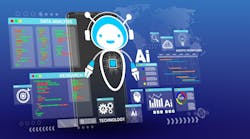Manufacturing AI Is about Good Data, Not Big Data
Manufacturing is starting to adopt AI to boost efficiency but current AI approaches won’t always work.
For sure, AI promises to be a game-changer in manufacturing via automating tasks, improving predictive maintenance, reducing downtime and improving quality and efficiency of production lines and supply chains.
Yet manufacturing has been slow to adopt AI, with less than 10% of manufacturing executives having implemented anything in recent years. The reasons? PwC perhaps said it best in a 2020 report on AI in manufacturing: AI is “highly complex, time-consuming, and capital intensive, and requires a comprehensive, systematic approach if it is to prove successful.”
New approaches are needed to unlock the value of AI in manufacturing and other legacy industries. This new approach is what we call “data-centric AI.” Humans will be key, as will a new way of looking at AI data.
Right Data, Not Huge Data
Many AI models rely on huge datasets, like those amassed by consumer internet companies such as Google, Facebook and Amazon. They get data every second from millions, or billions, of consumers.
But manufacturers, and individual factories—even individual production lines—don’t always have huge data sets to feed AI engines to target specific issues. They may have limited data sets, maybe just dozens, to train AI models to do what manufacturers need, like spot defects in products before they get too far down the production line.
The past decade of AI, taught in today’s engineering schools, focuses on having AI engineers train AI models based on huge data sets to detect the difference between a cat and a dog in images, for instance, or a long sweater from a short one preferred by the person reading a story on an Internet site.
In a factory, huge data sets for product defects are probably not part of the equation. Most factories don’t produce defective goods, so there’s not a lot of data to go on.
Humans Are Key to the Right Data
Instead, in many instances, manufacturers need good data and the right data to train an easy-to-deploy AI solution.
For manufacturers to make sure the right data gets into the AI engine, they need humans. They need the factory floor or process experts to tell the AI engineers, “This is the data we need, not that,” to ferret out the difference between a meaningless scratch on a manufactured component versus a defect that would make the component unsellable.
With data-centric AI, the technology will be useful and available to legacy industries, in addition to the consumer Internet giants, which drove the first AI era.
For manufacturers who’ve yet to implement AI, here are four steps to getting started with a data-centric approach:
1. Involve the subject-matter expert on day one. Today, many manufacturers start with an AI team of IT engineers who train AI models, perhaps with limited input from subject-matter experts, and then hand the AI models off to the factory floor experts to deploy. This may work, but often it doesn’t. That’s because only subject-matter experts know what’s most important in the hundreds of moving variables in a manufacturing operation. By involving the subject-matter expert deeply from the beginning, the team will be more likely to pinpoint what it wants the AI to learn, and identify the needed and available data to make that possible.
For instance, one manufacturing plant had a team of five AI engineers who honed a model to spot product defects. But the AI engineers, who weren’t intimate with the manufacturing process, missed a crucial difference between one data point and another. It took a 30-year-veteran of the plant to know that detail, which made all the difference.
2. Build consensus on what the right data is. In practically any company or industry, different people and departments use different terms to describe the same thing. To have a smooth-running AI program, data needs to be labeled consistently so the AI can pick up all of the relevant instances. If using AI to spot product defects, for instance, images of defects need to be consistently labeled and collected in a central place. That way, the subject-matter expert, the AI engineer and the labeler produce and access consistent data. With consensus, you’ll also limit discrepancies in what constitutes a product defect, for instance, and reduce false positives.
3. Be prepared to iterate. Despite best efforts, the first AI model will probably not work. That’s because inconsistencies in labeling or qualifying data will sneak through. It will be the job of the first AI model to ferret those out, and then have the subject-matter expert identify whether they’re important or not. AI engineers can spend a lot of time fixing the AI model but not actually address what’s important to the manufacturing operation. By continually iterating, your AI model and process will get better and better.
4. Select the right project. Don’t tackle the biggest problem first. Find a clearly defined problem and put AI to the task. By securing a win on the first project, you’ll make believers out of more people, both in the factory and on the AI engineering team. That momentum will help drive more and more projects.
In the data-centric AI era, the key will be to have the right data, not necessarily big data, so that the AI model measures what is needed and can deliver results even with limited data. Since so many companies will have only limited data, the data-centric approach will extend the benefits of AI to ever more industries.
Kai Yang is vice president of products, Landing AI.





